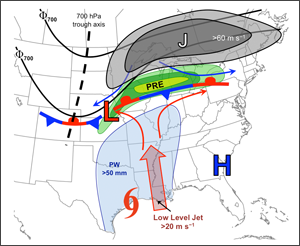HMT/HMT-SE Begins Research on Predecessor Rain Events
Research on PREs began at the University at Albany as part of the Collaborative Science, Technology, and Applied Research (CSTAR) Program in 2005. Matthew Cote made the first contribution to PRE research with the completion of his Master's thesis in May 2007. He identified 47 PREs that occurred over the United States (US) during 1998–2006 in association with 21 tropical cyclones. Dr. Thomas Galarneau and Benjamin Moore, who began working for HMT at NOAA/ESRL in August 2010, extended Cote's research while they were finishing their Doctoral and Master's degrees, respectively, at the University at Albany as part of the CSTAR program. Studying 28 PREs that occurred during 1995–2008, Galarneau and fellow researchers found that PREs were most common in August and September and approximately 30% of all western North Atlantic tropical cyclones were associated with at least one PRE. Case studies by Galarneau and Moore showed that PREs develop in response to a plume of deep tropical moisture that comes from the tropical cyclone and is carried poleward.
PRE research has helped NOAA forecasters become increasingly aware of these events. Galarneau and Moore will continue their research on PREs as part of HMT, primarily in the southeastern US. They plan to conduct additional case studies of PREs over the US east of the Rockies to better understand the full spectrum of PREs and compare the structure and dynamics of PREs with atmospheric rivers that have been studied extensively at NOAA/ESRL. Additionally, they will examine the predictability of and assess model forecast skill for PREs using ensemble datasets. The goal is to determine if there are any deficiencies in the models that could contribute to poor quantitative precipitation forecasts (QPFs) during PREs. It is hoped that QPFs during PREs will be improved with increased awareness by forecasters and better model forecasts.
References:
Bosart, L. F., T. J. Galarneau, Jr., J. M. Cordeira, and B. J. Moore, 2010: Extreme rainstorms in advance of tropical cyclones. Bull. Amer. Meteor. Soc., 91, 854-856.
Galarneau, T. J., Jr., L. F. Bosart, and R. S. Schumacher, 2010: Predecessor rain events ahead of tropical cyclones. Mon. Wea. Rev., 138, 3272-3297.
Moore, B. J., 2010: Synoptic-scale Environments and Dynamical Mechanisms Associated with Predecessor Rain Events Ahead of Tropical Cyclones. M.S. Thesis, Department of Atmospheric and Environmental Sciences, University at Albany, State University of New York, 150 pp.
